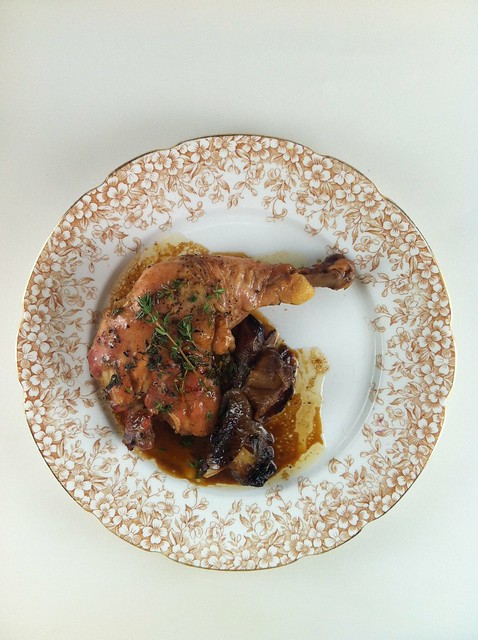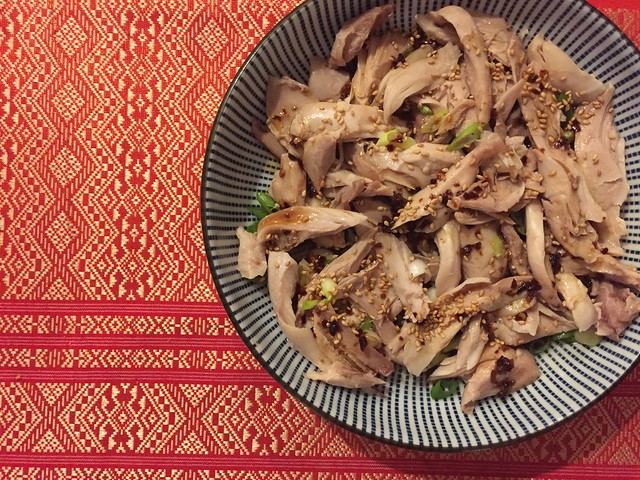I roast chicken for myself at least once a month because there’s always a lazy, quiet day that’s perfect for a properly roasted chicken. What I didn’t know until this past weekend is that I can roast one and serve it to dinner guests. I always want to impress when I invite guests to my home and have always thought that the more work I put into cooking, the better the food. And it has been for the most part; I just never thought chicken was something that would bowl people over. With this recipe, however, using sherry vinegar sauce and then served with other dishes that included apples, it made a whole autumn feast presentable. I saved so much time cooking chicken instead of my usual repertoire that I was able to make three separate vegetable sides plus a cake for dessert!

If you have a good butcher, ask them to debone the chicken and cut in half, but leaving the legs and wings intact. You may also buy separate chicken pieces; about 3 pieces will fit into a large oven-safe skillet. If you have an iron grill press, it’s good to use it to keep the chicken pieces flat. If you only have a Teflon frying pan (which you certainly can’t put inside the oven), you’re better off using the same baking pan you’re using for the shallots just so it’s hot before cooking the chicken–just remove the shallots after roasting to avoid burning them.
I also saved the rendered fat from the chicken and for leftovers the next day. I fried some white rice and added a blob of it (there’s no better way to describe it) to make a quasi-Hainanese chicken rice. It was so delicious and guiltily satisfying with some pickled cornichon to cut through the grease.
Ingredients:
6 pieces of chicken thighs and breasts
salt and pepper
10 shallots, peeled
a stick of butter
vegetable oil
1/4 cup of sherry vinegar
thyme sprigs
1. Preheat the oven to 425º. Season the chickens generously on both sides with salt and pepper. Set aside.
2. Place the 6 of the whole shallots in a small baking pan. Toss with salt and pepper, add a medium-sized knob of butter and pour in 1/4 cup water. Cover with aluminum foil and roast for 20 minutes. Uncover and roast for 15 minutes longer or until the shallots are tender and golden. Set the pan aside.
3. When you’re ready to roast the chickens, place two oven-safe skillets in the oven for 15 minutes. When the skillets are hot, carefully remove them from the oven and add vegetable oil to each skillet. Place 3 chicken halves in each skillet, skin side down. Roast for about 30 minutes,
checking halfway through, until the juices from the thigh run clear.
4. Remove the skillets from the oven and pour off the fat in a separate container for later use. Turn the chicken pieces over, skin side up and deglaze each pan with 1/4 cup of sherry vinegar, gently scraping the bottom to release any browned bits. Add another knob of the butter, thyme and 2 shallots to each pan. Return to the oven and roast for 3 extra minutes.
6. To serve, place a chicken piece, a couple of shallots and a bit of the pan sauce on each plate. Fry some rice with the chicken fat for an Asian flair. Garnish your plates with thyme sprigs.
If you have more time and feeling like you need a challenge, why don’t you try to prepare your own chicken suprême, or a semi-boneless poultry breast half with the wing joint still attached? A new iPad app from Inkling called The Professional Chef has amazing videos and photographs from the Culinary Institute of America. Unlike cooking demos on TV, you don’t get bogged down by the screaming obnoxious white-haired guy–you can just concentrate on the cooking matter at hand with the calm narrating voice guiding you at every step. You may buy each chapter for $2.99 (Chapter 16: Fabricating Meats, Poultry, and Fish) or the entire app for less than $50 using the link below.
Recommended tool/s:
The Professional Chef iPad app from the Culinary Institute of America




